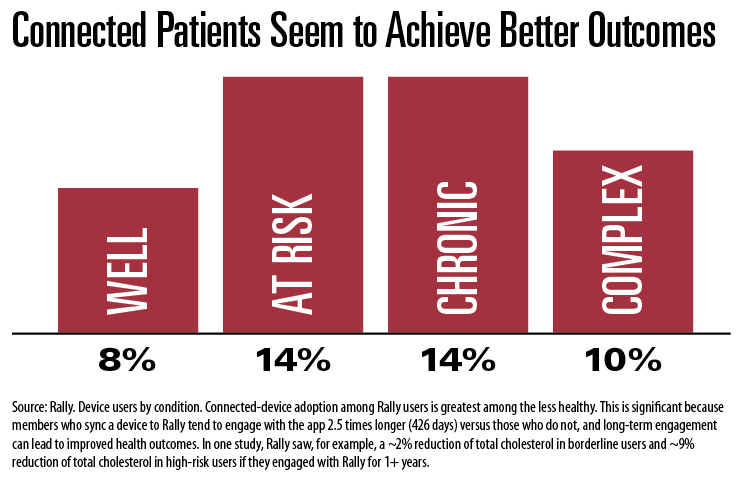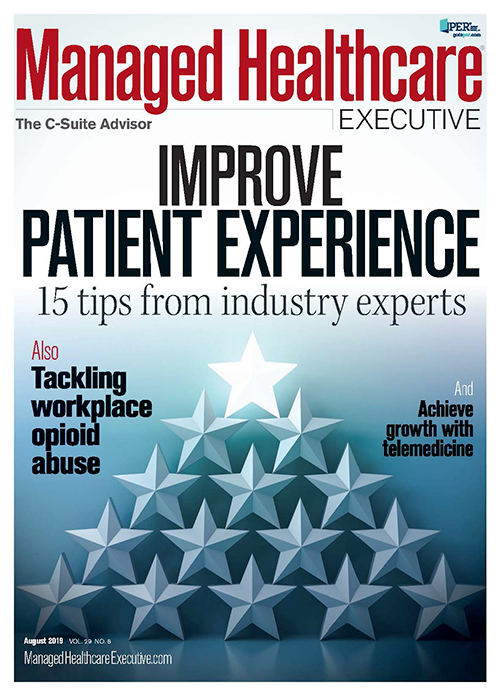The Future of Healthcare Wearables
How payers and health systems are using wearables to monitor patient health and encourage healthy behaviors.

Click to expand

Many women in rural areas in the United States need to travel an hour or more to get to a hospital where they can give birth, according to the American College of Obstetricians and Gynecologists (ACOG). Obstetric units are often the first to close when hospital budgets get tight.
By 2010, 49% of U.S. counties-predominantly rural counties-had no obstetrician–gynecologist. In some counties, all obstetric care is provided by family physicians. And according to ACOG, the number of OBGYNs in the rural workforce could continue to decrease.
New Orleans-based Ochsner Health System supports expectant mothers with its free Connected MOM (Maternity Online Monitoring) digital medicine program, which means fewer visits to the obstetrician.
Mothers-to-be receive a wireless blood pressure cuff and dipsticks and cups for urine protein tests, which can be used at home to test urine and securely send the results to the care team via the patient’s smartphone. They also get a wireless scale to send real-time weights to a health coach and obstetrician via their medical chart at least once a week; patients receive reminders on their smartphones if they forget.
Related article: Six Healthcare Technologies Coming in the Next 10 Years
Launched in December 2017, Connected MOM is the first such program created by a health system, according to Ochsner. As of March, 1,000 women were enrolled in the program, reports CNBC. Citing the American College of Obstetricians’ guideline that the standard prenatal care model for low-risk pregnancies requires between 12 to 14 office-based prenatal visits, the health system says the Connected MOM program connects patients with their care team while reducing the need for at least three office visits and increasing flexibility and convenience for patients.
“Digital health programs have an opportunity to create access in areas where there isn’t always access,” says Aimee Quirk, CEO of innovationOchsner, an innovation lab and accelerator founded by the health system that focuses on increasing care quality while reducing cost and improving the patient experience. Challenges for patients can include difficulty accessing transportation or getting time away from work or family responsibilities, she adds.
“This is a really powerful way to help address some of the access issues and disparities we see,” says Quirk.
Wearables and chronic disease management
Ochsner also supports patients with chronic conditions such as hypertension and diabetes with digital health programs including wearables, says Quirk. “We recognize that the acute care model, which is the model of care today, is changing. We’re seeing it change because of payment incentives.”
To support patients and non-patients, the health system launched the O Bar, retail locations where patients and non-patients can purchase activity monitors, wireless blood pressure monitors, and weighing scales. Shoppers also have access to technology specialists who help them choose the appropriate digital health app, while providing technical and set-up support.
The first O Bar opened at its medical center in Baton Rouge in May 2018, and there are now seven O Bar locations at health system facilities. Available to serve community members in other locations is the mobile O Bar, which travels to Ochsner hospitals. Expectant mothers can pick up materials for the Connected MOM program at an O Bar, says Quirk.
UnitedHealthcare members increase steps
UnitedHealthcare Motion uses wearable devices to capture members’ required 10,000 daily steps to help them earn as much as $1,095-or $3 per day-toward their health savings account each year. The program is available to members in more than 40 states.
Launched by the payer as a pilot program in 12 states in 2016, the program started because there’s a “significant body of evidence that movement and motion can have a meaningful impact on the quality of life,” says Paul Sterling, vice president of emerging products.
While physicians have been recommending for years that patients should be active, starting that activity and remaining engaged can be challenging, he adds.
Activity trackers and smart watches available through the program include devices from Samsung, Garmin, Fitbit, and Apple. For members in the program, UnitedHealthcare subsidizes $55 toward the cost of an activity tracker or smart watch. Participants who already have a device receive $55 worth of credit in the program.
Collectively, members who participate in the program have walked more than 180 billion steps and earned just shy of $30 million in rewards since the program’s inception.
People with chronic conditions are 20% more likely to participate in Motion than people not managing these conditions, according to UnitedHealthcare. Specifically, people with diabetes are 40% more likely to participate in the program than people without the condition.
Members’ participation in the program can translate into cost savings for employers, according to the payer. Members who participate in Motion have been shown to cost $222 less than members who don’t participate.
Consumerism, crunching data, managing costs
Hypertension, heart failure, and diabetes. Those are the conditions typically tracked by wearable technology, says Andrew Rebhan, consultant with Advisory Board’s Healthcare IT Advisor. One of the biggest drivers behind these programs-certainly for payers and providers-is the need to monitor patients in the home and keep them out of the hospital, he adds.
But Rebhan also attributes the interest in wearable technologies to the rise in the consumerism in healthcare. “It’s the idea that consumers have more ‘skin in the game’ with high deductibles. They’re trying to become more engaged in their own care. That’s while their employer or payer is trying to manage costs.”
Related article: Healthcare Technology in a Post-Digital Age
The challenge for providers is the need to turn large volumes of clinical data into actionable information, says Rebhan. That requires the collection and analysis of the data, and getting it into clinicians’ workflow to intervene if, for example, a patient’s heart rate spikes.
What’s next in wearable technology?
According to Rock Health, 87% of consumers were using a digital health platform in 2017 (the latest year data was available)-that’s an increase from 80% in 2015.
As the technology that powers these devices continues to become more powerful and less expensive, Karl Ulfers, chief product officer at Rally Health, which develops digital health platforms that educate employees about their healthcare-related decisions, expects that the return on investment of using these devices more broadly in the population will grow. He also anticipates a shift from chronic disease management to chronic disease prevention.
Aine Cryts is a writer based in Boston.

In the Scope of Virtual Health and the Future of “Website” Manner, Per Ateev Mehrotra
August 10th 2023Briana Contreras, an editor of Managed Healthcare Executive, had the pleasure of catching up with MHE Editorial Advisory Board Member, Ateev Mehrotra, MD, MPH, who is a professor of healthcare policy at Harvard Medical School and an Associate Professor of Medicine and Hospitalist at Beth Israel Deaconess Medical Center.
Listen
Extending the Capabilities of the EHR Through Automation
August 2nd 2023Welcome back to another episode of "Tuning In to the C-Suite," where Briana Contreras, an editor of Managed Healthcare Executive, had the pleasure of chatting with Cindy Gaines, chief clinical transformation officer at Lumeon.
Listen